Introductory remarks: The Paleogene Foramifera
The Cretaceous-Paleogene crises wiped out over 80% of the larger benthic foraminifera, thus, the Early Paleogene served as a recovery period for the larger foraminifera species that survived. During this time, large foraminifera remained rare and morphologically small. Newly evolved forams exhibited the "Lilliput effect" (Twitchett, 2006) which is described by a notable size decrease after an
extinction event or an ecological stress. Larger miliolines and rotaliines (nummulitids and orthophragmiids) appeared during the Late Paleocene and spread throughout the Tethys region. The agglutinated textulariines developed along with these aforementioned lines of lineage and resembled their Cretaceous ancestors by having internal pillars and complicated partitions.
The recovery period in the Tethys proved a much shorter-lived period when compared to the American province. Rotalinnes did not begin to develop new lineages prior to the Middle Eocene and evolved into three-layered Lepidocylina and Eulepidina. These forms migrated into the Tethys during the Oligocene. The nummulitids in the American province never reached the large sizes of the nummulitids of the Tethyan realm.
This page aims to summarize the taxonomy of the most significant large benthic foraminifera that appeared during the Paleogene (eg. Paleocene, Eocene, Oligocene). The three major suborders that thrived during the Paleogene were:
Textulariina, Miliolina and
Rotaliina (see figure below).
Superfamilies, families and genera of these suborders will be discussed following the text of
Dr. Marcelle K. BouDagher-Fadel of the University College of London (University College of London - MIRACLE). Chapter 6 of BouDagher-Fadel (2008) presents a comprehensive overview of the main genera of the Paleogene larger foraminifera and prominent researchers, evolutionary lineages and phylogenetic relationships, biostratigraphic ages and paleoenvironmental interpretations.
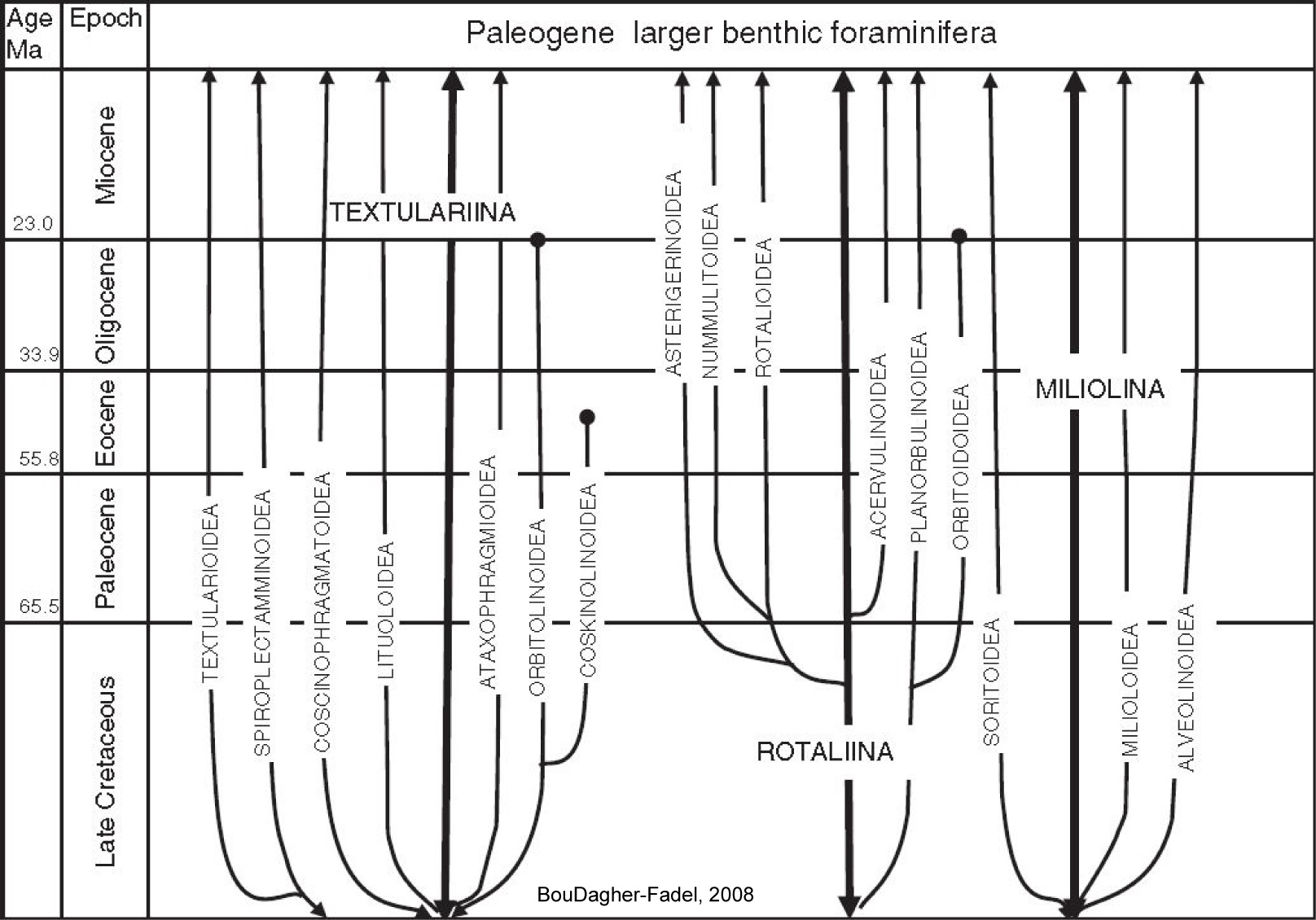
The three suborders of larger benthic foraminfera that dominated the Palaeogene include the Textulariina, Miliolina and Rotaliina. The above illustration shows the relationship and evolution of the superfamilies of these suborders (BouDagher-Fadel, 2008, pg. 298)
SUBORDER TEXTULARIINA
- Test: all forms have an enrolled second chamber
- Wall: aragonitic but commonly recrystallized to give a homogeneous microgranular structure. Umbilical region has pillar-like structures on one or both sides of their test
- Geologic range: Early Cambrian to Holocene
Superfamily ATAXOPHRAGMIOIDEA
- Test: multilocular, trochospiral, becomes biserial or uniserial in later stages
- Geologic range: Middle Triassic to Holocene
Family Globotextrlariidae
- Test: highly trochospiral stage followed by a quadriserial, triserial or biserial stage. The interior of the chambers may be subdivided by internal partitions.
- Wall: non-canaliculated
- Geologic range: Late Cretaceous to Holocene
- Genera: Cubiana; Liebusella; Matanzia
Superfamily PAVONITINOIDEA
- Test: early stage is coiled, triserial to biserial or uniserial. The interiors of the chambers are partially divided by numerous vertical partitions (beams) or septula, that project downwards from the roof and rarely may have a few connecting horizontal partitions (rafters).
- Geologic range: Late Cretaceous and Oligocene to Pliocene
Family Pavonitinidae
- Test: palmate, triangular in section, early stage coiled triserial to biserial or uniserial. Interior of chambers partially divided by numerous vertical partitions (beams) or septula that project downwards from the roof and rarely may have a few connecting horizontal partitions (rafters).
- Aperture: terminal single or multiple
- Geologic range: Oligocene to Pliocene
Subfamily Spiropsammiinae
- Test: strongly compressed, later stages may be uncoiled.
- Interior of chambers: subdivided by numerous elongate septula
- Aperture: single, terminal
- Geologic range: Oligocene to Early Pliocene
![]() 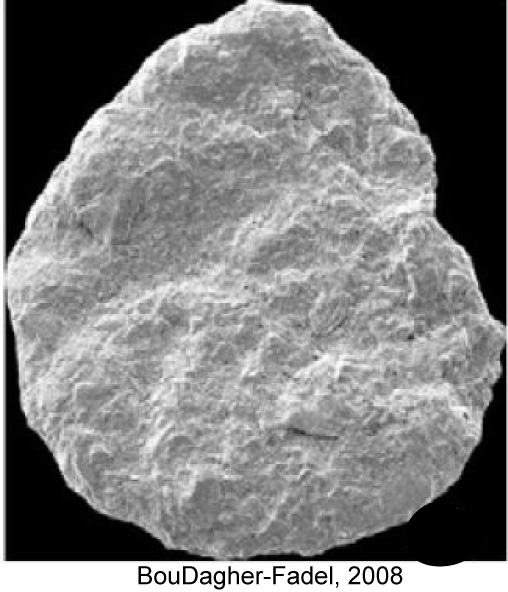 |
Test: early stage evolute, planispirally enrolled, but later uncoiled and rectilinear.
Aperture: single, terminal
Geologic range: Oligocene to Early Pliocene
|
Subfamily Pavonitininae
- Test: triserial, biserial or uniserial
- Chambers: undivided by secondary septula
- Geologic range: Oligocene to Miocene
- Genera: Pavonitina; Pavopsammia; Zotheculifida
Superfamily COSCINOPHRAGMATOIDEA
- Test: free or attached, may be coiled in the early stages, later uncoiled or branched
- Wall: finely agglutinated, traversed by pores, or with a coarsely perforate or canaliculate inner layer and an outer imperforate layer
- Geologic range: Triassic to Holocene
Family Haddoniidae
- Test: attached
- Aperture: terminal simple to complex
- Geologic range: Paleocene to Holocene
- Genera: Haddonia
Superfamily TEXTULARIOIDEA
- Test: trochospiral, biserial or triserial in early stages and later may be uniserial or biserial.
- Wall: agglutinated, canaliculated
- Geologic range: Early Jurassic to Holocene
Family Chrysalidinidae
- Test: high trochospiral, with quinqueserial or quadriserial or triserial or biserial coiling modes, or with certain consecutive pairs of these
- Aperture: central along the axis of coiling
Subfamily Chrysalidininae
- Triserial throughout its ontogeny becoming biserial or quadriserial in th eadult
- Wall: solid but sometimes becomine canaliculate
- Geologic range: Early Jurassic to Late Eocene
Superfamily LITUOLOIDEA
- Test: multilocular, rectilinear and uniserial
- Aperture: simple or multiple cribrate
- Geologic time: Early Jurassic to Holocene
Family Cyclamminidae
- Test: involute with alveolar walls
- Aperture: near septal face
- Geologic range: Jurassic to Holocene
![]() 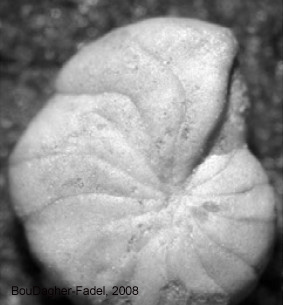 |
Test: planispiral, flattened.
Wall: thick alveolar subepidermal meshwork of a thickness exceeding that of the chamber lumen.
Geologic range: Paleocene to Holocene
|
Family Lituolidae
- Test: Ealry stage is enrolled, later may be rectilinear
- Wall: agglutinated foreign particles
- Geologic range: Jurassic to Holocene
Family Spriocyclinidae
- Test: planispiral becoming peneropliform to annular in later stages
- chambers: partially subdivided by septula
- Geologic range: Jurassic to Eocene
![]() 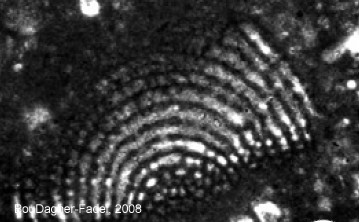 |
Test: Microspheric forms with a uniserial flabelliform last stage.The megalospheric stage has a large proloculus and evolute, annular last stage.
Chambers: possess a superficial subepidermal cellular layer (‘‘pigeon-hole’’structure)
Geologic range: Paleocene to Middle Eocene
|
Superfamily COSKINOLINOIDEA
- Test: conical with a trochospiral early stage, becoming uniserial and rectilinear
- Geologic range: late Cretaceous to Middle Eocene
Family Coskinolinidae
- Test: simple, or without exoskeleton in the marginal chamber cavity
- Aperture: a series of pores scattered over the apertural face
- Geologic range: Late Cretaceous to Middle Eocene
![]() 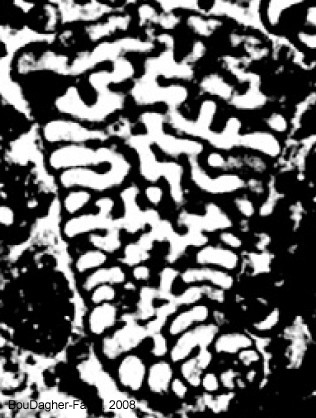 |
Test: highly conical with a
trochospiral early part followed by a uniserial part with a slightly convex base.
Chamber: subdivided by vertical partitions more or less in line from one chamber to the next. The megalospheric apparatus has simple walls and consists of two chambers divided by a very thin, straight septum, separating the protoconch from
the deuteroconch.
Geologic range: Early to Middle Eocene
|
![]()  |
Test: Early stage trochospiraly enrolled but without partitions: later parts with few scattered pillars
Geologic range: Early to Middle Eocene
|
![]() 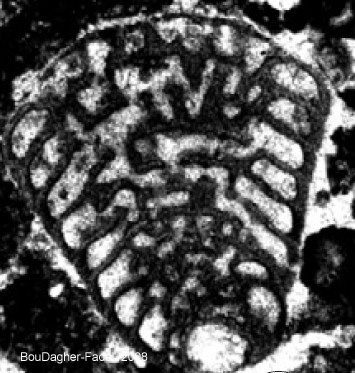 |
Test: inside of test has vertical partitions and pillars. no exoskeleton in the marginal chamber cavity
Geologic range: Paleocene to Middle Eocene
|
![]() 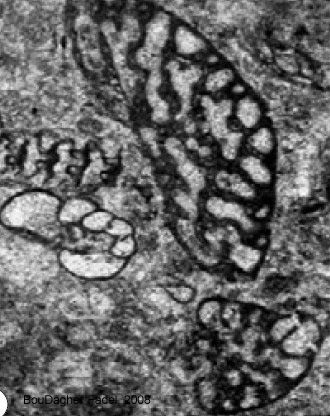 |
Test: Very reduced arenobuliminid early growth stage, with later part being uniserial with scattered pillars. No exoskeleton in the marginal chamber cavity.
Geologic range: Middle Paleocene to Middle Eocene
|
Superfamily ORBITOLINOIDEA
- Test: conical with numerous chambers, partially subdivided by radial or transverse partitions or with pillars
- Geologic range: Middle Jurassic to Oligocene
Family Orbitolinidae
- Test: initial, low trochospire, usually very much reduced, followed by a later rectilinear, broad and conical growth, made of low uniserial chambers subdivided with pillars or vertical partitions.
- Aperture: cribrate
- Geologic range: Middle Jurassic to Oligocene
Subfamily Dictyoconinae
- Test: Embryonal apparatus consisting of a protoconch and deuteroconch
- Geologic range: Middle Jurassic to Oligocene
![]() 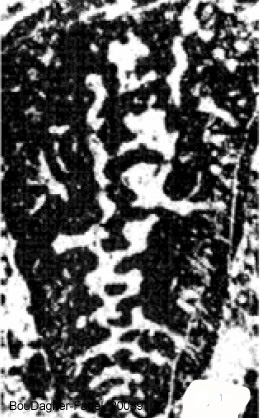 |
Test: low to high conical form in late ontogeny, with three chambers in each whorl. The embryonic apparatus is followed by a series of trochospiral chambers, subdivided by a network of vertical beams and horizontal partitions. The central zone is divided by numerous pillars.
Geologic range: Paleocene
|
![]() 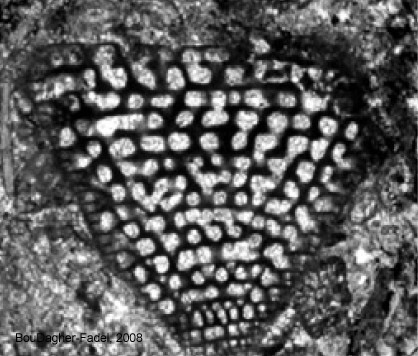 |
Test: The early trochospiral is very reduced, with an apical protoconch.
Chamber: divided by short vertical partitions, which are intersected by at least two horizontal partitions.
Geologic range: Middle Eocene
|
![]() 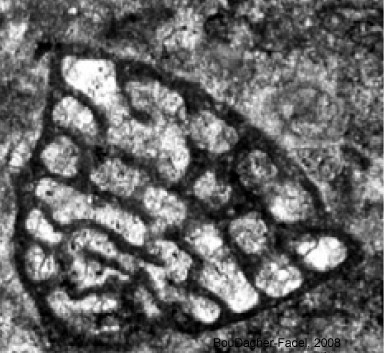 |
Test: initial part almost planispiral.
Walls have vertical partitions in the marginal zone, which Hottinger (2007) interpreted as septula comprising a part of the endoskeleton, but lacking horizontal partitions.
Geologic range: Early to Middle Eocene
|
![]()  |
Test: Radial partitions thicken away from periphery,
and become broken up into pillars in central zone. Peripheral tiered rectangular chamberlets are present.
Geologic range: Aptian to Oligocene
|
![]() 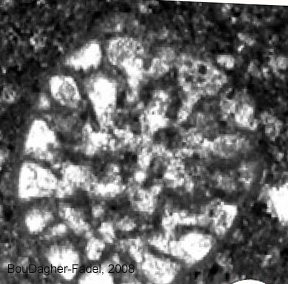 |
Test: The early trochospiral coil is very reduced. The uniserial part is pillared, and has a thick marginal wall. The exoskeleton is simple (only beams) or moderately complex (beams and rafters).
Geologic range: Middle to Early late Paleocene
|
![]() 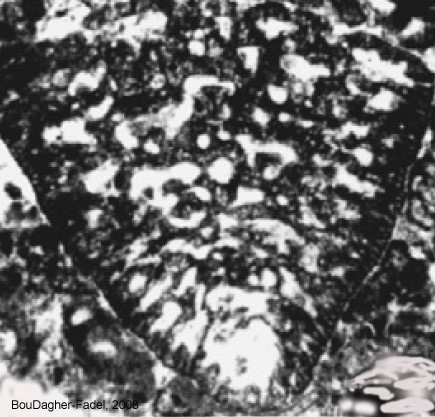 |
Test: This form differs from the Late Cretaceous Calveziconus as it has a more complex internal structure, with more than two vertical (beams) and horizontal (rafters) partitions forming an irregular network under the epidermis.
Geologic range: Paleocene
|
![]() 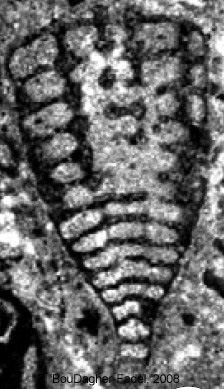 |
Test: The early trochospiral stage is absent.
Chamber: biserial in the early part, becoming uniserial in later stages. Interior of chambers is subdivided by vertical partitions (beams) that are aligned from chamber to chamber, forming a ring round the central shield which is supported by pillars.
Geologic range: Early Eocene
|
SUBORDER MILIOLINA
- Test: porcelaneous, imperforate, and made of high–magnesium calcite with fine randomly oriented crystals.
- Geologic range: Carboniferous to Holocene
Superfamily ALVEOLINOIDEA
- Test: enrolled enrolled along an elongate axis, initially planispiral or streptospiral, or milioline with chambers added in varying planes.
- Geologic range: Cretaceous to Holocene
Family Alveolinidae
- Test: free, large, planispiral to fusiform, subcylindrical or globular, coiled about elongate axis. Early whorls may be irregular, streptospiral in monomorphic species, and may be restricted to microspheric forms in dimorphic species.
- Chambers: subdivided into chamberlets by longitudinal partitions (septula) perpendicular to the main septa, and connected by passages below the apertural face. The basal layer may include anastomosing canals (Hottinger et al., 1989).
- Aperture: a slit parallel to the base of the apertural face, or a single row of circular openings, or numerous rows of such openings in horizontal rows, arranged in definite patterns matching the patterns of chamber divisions.
- Geologic range: Early Cretaceous (Aptian) to Holocene
- Genera: Alveolina; Borelis; Bullalveolina; Globoreticulina; Glomalveolina; Malatyna; Praebullalveolina;
![]() 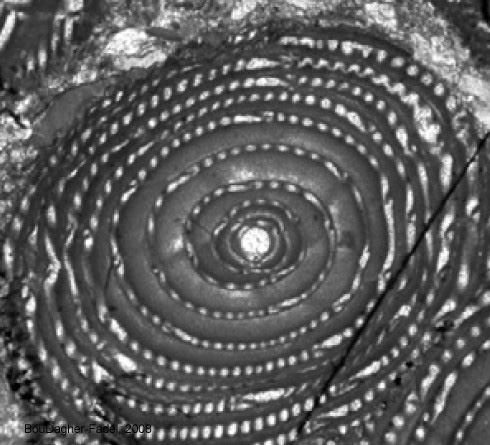 |
Test: large, fusiform or cylindrical with single tier chamberlets alternating in position in successive chambers. The basal layer is thick, as deposition of secondary calcite (flosculinisation)
fills most of the chamber lumen. Successive chambers communicate with post and
pre-septal passages. The final chamber has two rows of apertures alternating in position.
Geologic range: Late Paleocene to Eocene
|
![]() 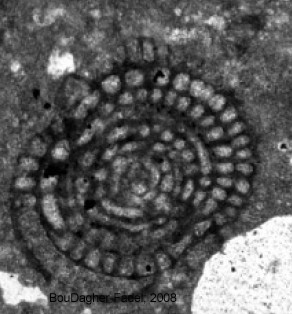 |
Test: small, spherical to fusiform. It differs from
Alveolina in having only a pre-septal passage and a secondary small tier of chamberlets which alternate with the larger ones producing ‘‘Y’’ shaped septa in
axial section.
Aperture: single row of pores
Geologic range: Late Eocene to Holocene
|
![]()  |
Test: globular, planispiral, involute with an alveolar
exoskeleton and only the final whorl visible on the exterior. The outer parts of the chambers are subdivided by parallel and transverse partitions.
Aperture: cribrate
Geologic range: Middle Eocene
|
![]()  |
Test: spherical with early streptospiral
coiling. Later chambers have septula complete from floor to roof. The pre-septa passage is large. The apertural face has one row of primary apertures intercalated with smaller secondary apertures.
Geologic range: Late Eocene
|
Family Fabulariidae
- Test: large, dimorphic, multichambered with milioline coiling, tending to become reduced in subsequent growth stages, either to bilocular or to monolocular chamber cycles.
- Aperture: trematophore
- Chambers: show a thickened basal layer, subdivided by pillars or secondary partitions. Foraminifera in adult growth stages have a fixed apertural axis.
- Genera: Fabularia; Lacazina; Lacazinella; Neolacazopsis; Pseudofabularia; Pseudolacazina
![]() 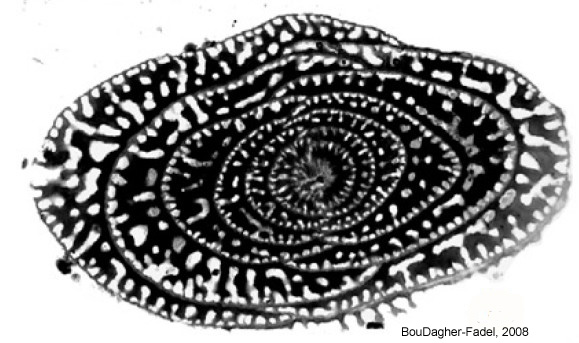 |
Test:
ovate, quinqueloculine in early stages and biloculine in later stages. Chambers have thick walls and are subdivided by subepidermal partitions, forming a series of chambers that are connected by preand post-septal passages.
Aperture: cribrate (trematophore).
Geologic range: Middle to late Eocene
|
![]() 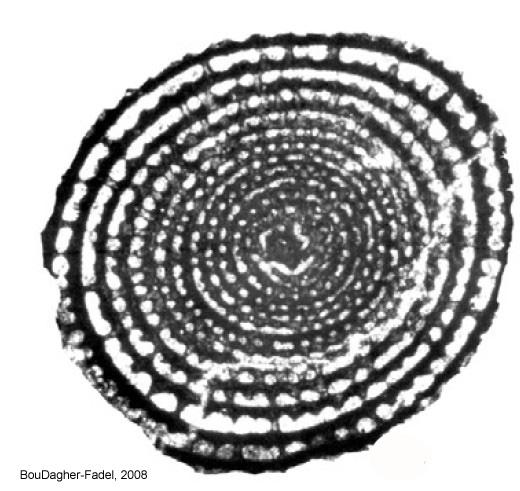 |
Test: large, discoid to ovoid, dimorphic. The early milioline coiling is followed by chambers that partially embrace the early ones. Longitudinal ribs are
directed from one foramen to the next, so that each supports a single row of regularly spaced pillars, reaching the chamber roof and alternating in their position in adjacent rows.
Aperture: cribrate (tramatophore) at one extremity of the test
Geologic range: Late Cretaceous to Early Oligocene
|
![]() 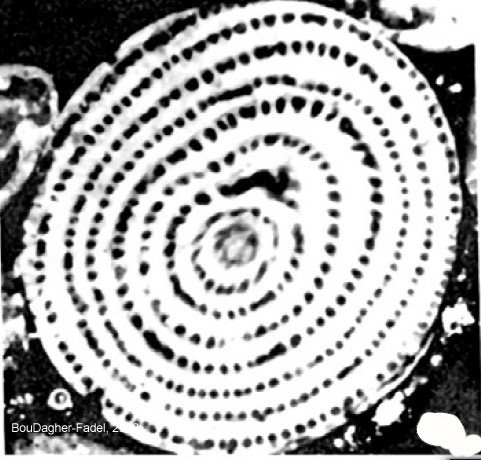 |
Test: ovoid, with concentric chambers completely embracing and divided by low longitudinal partitions that do not reach the chamber floor and support the trematophore.
Geologic range: Later Paleocene to Eocene
|
Superfamily MILIOLOIDEA
- Test: coiled in varying planes with two chambers per whorl, with the axis of coiling normal to the apertural axis and rotated, so that several angles exist between the median planes of consecutive chambers, such as 721 (quinqueloculine), 1201 (triloculine) or 1801 (spiroloculine or biloculine). The test may become uncoiled, cylindrical or compressed with partial partitions. The proloculus is followed by a spiral passage.
- Aperture: single and may be accompanied by additional teeth that project from the opposite margin of the aperture, from the chamber roof or from the lateral wall, or with a sieve (trematophore)
- Geologic range: Late Triassic to Holocene
Family Austrotrillinidae
- Test: Milioline type
- Wall: coarse alveolar
- Geologic range: Middle Eocene to Middle Miocene
![]() 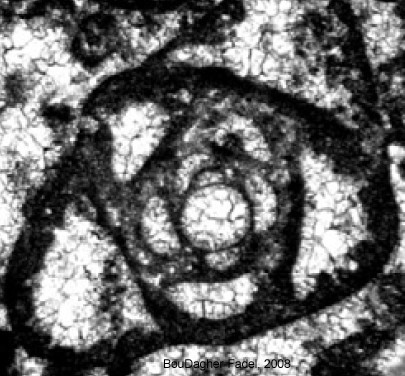 |
Test: triloculine with fine to coarse blind alveoles that can bifurcate.
Aperture: simple tooth in the early chambers, branching to form smaller openings in the adult.
Geologic range: Middle Oligocene to Middle Miocene
|
Family Hauerinidae
- Test: early part test has a globular proloculus followed by two chambers per whorl. The chambers may be added in a quinqueloculine arrangement, but later may be uncoiled.
- Aperture: range from a simple to a bifid tooth or may be a trematophore.
- Geologic range: Jurassic to Holocene
- Genera: Heterillina; Kayseriella
![]() 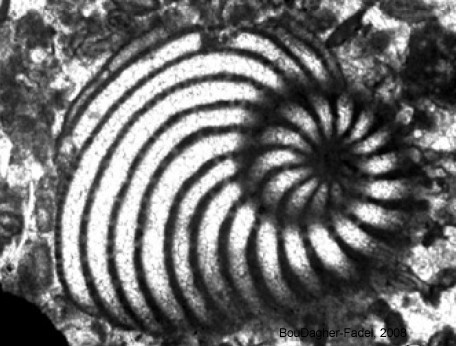 |
Test: rounded, early chambers with a quinqueloculine arrangement, later planispiral and evolute.
Aperture: a trematophore
Geologic range: Middle Eocene to Oligocene
|
Family Rivieroinidae
- Test: planispiral and ovate in outline with chambers that are subdivided by oblique sutures
- Geologic range: Middle Eocene to Holocene
- Genera: Pseudohauerina
Family Spiroloculinidae
- Test: planispiral consisting of a cornuspirine flexostyle, followed by a biserial part
- Aperture: simple, single basal opening with a bifid tooth
- Geologic range: Middle Jurassic to Holocene
- Genera: Elazigella
Superfamily SORITOIDEA
- Chamber: planispiral, uncoiling, flabelliform or cyclical, and may be subdivided by partitions or pillars
- Geologic range: late Permian to Holocene
Family Peneroplidae
- Test: closely coiled in the early stage, becoming uncoiled in the later stage
- Chamber: interior simple
- Aperture: single rounded, slit-like or multiple
- Geologic range: Late Cretaceous to Holocene
- Genera: Archiacina; Dendritina; Haymanella; Hottingerina; Penarchaias; Peneroplis; Puteolina; Raoia; Spirolina
The progression from a peneropline shell to a completely annular test with
chambers divided by internal partitions developed in the Soritoidea
Family Soritidae
- Test: involute, planispiral to uncoiled evolute, flaring, annular discoid with partial or complete partitions
- Aperture: multiple
- Geologic range: Late Cretaceous to Holocene
- Genera: Amphisorus; Archaias; Cyclorbiculina; Cyclorbiculinoides; Mardinella; Neorhipidionina; Neotaberina; Opertorbitolites; Orbitolites; Praerhapydionina; Rhabdorites; Somalina; Sorites; Twaraina; Yaberinella
![]() 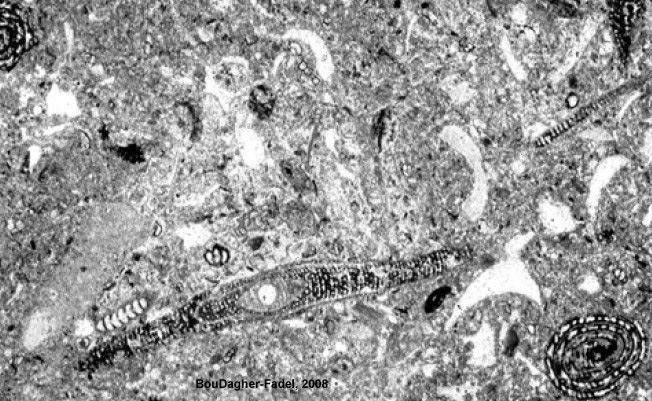 |
Test: large biconcave, circular with thickened edges
and two partial layers of chamberlets. C yclical chambers are divided by septula.
Aperture: The aperture consists of numerous pores aligned tn two alternating rows.
Geologic range: Latest Oligocene to Holocene
|
![]() 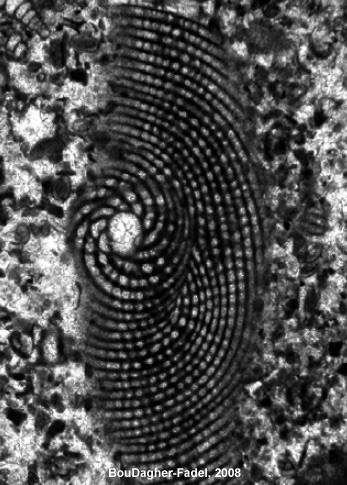 |
Test: compressed, planispiral and involute, may be partially evolute in the last whorls, with a thickened middle part. Multiple apertures are flanked by irregular free and interseptal pillars.
Geologic range: Middle Eocene to Holocene
|
![]() 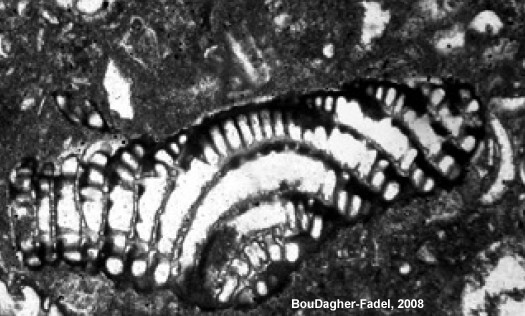 |
Test: planispiral, with an uncoiled flaring adult
part.
Chamber: subdivided by septula that are perpendicular to the outer chamber wall and end proximally with a slightly thickened rim. It has cribrate apertures on the apertural face with additional apertures appearing in the median plane as one or several rows..
Geologic range: Middle Eocene
|
![]() 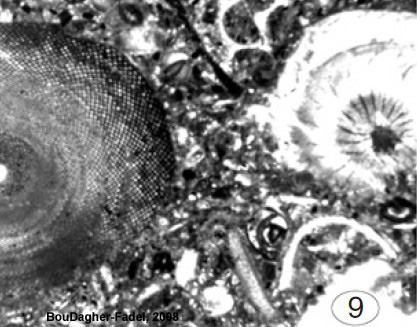 |
Test: lenticular, later chambers becoming cyclical
and divided into numerous small chamberlets. Compact umbonal thickening, made of lateral laminae, covers the umbilical regions.
Geologic range: Late Paleocene to Early Eocene
|
![]()  |
Test: large discoid, very slightly concave, with a large proloculus and inflated nucleoconch, followed by cyclic chambers divided into small numerous chamberlets with curved thickened walls. Adjacent chambers are connections are between the obliquely
adjoining chamberlets.
Geologic range: Early to Middle Eocene
|
![]() 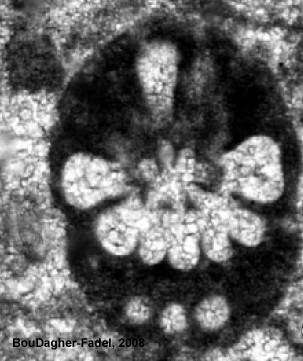 |
Test: elongate, subconical, planispiral, later uncoiled and circular in thin section.
Aperture: a single terminal aperture, on a strongly
convex face, has a petaloid to stellar outline with four to six rays. Between the petals of the aperture, peristomes protrude to form tooth-like features.
Geologic range: Middle Eocene
|
![]() 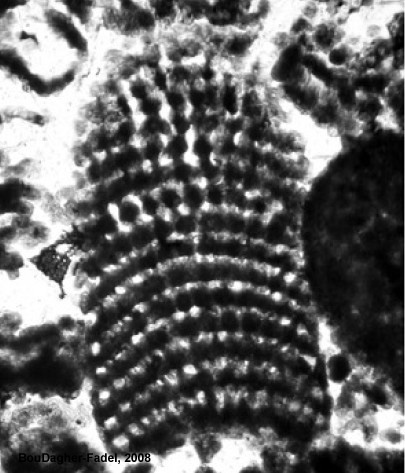 |
Test: soritid, with a short planispiral early part followed by a cylindrical to conical uniserial part with radial septula, and a large central preseptal space.
Apertures: multible
Geologic range: Middle Eocene
|
![]() 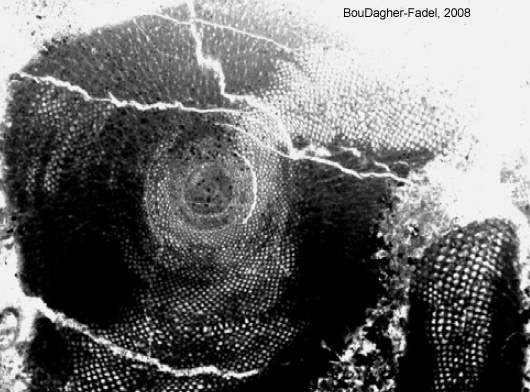 |
Test: large, lenticular to discoid with annular chambers subdivided into chamberlets, as in Orbitolites, but with crosswise stolons.
Geologic range: Middle Eocene
|
![]() 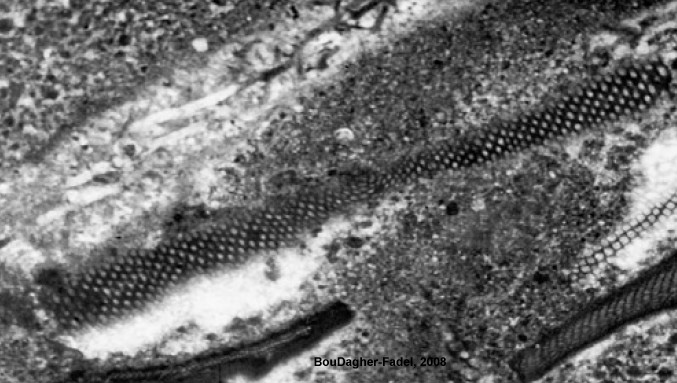 |
Test: large, discoid, with an early peneropline stage. Annular chambers are divided into numerous curved to rectangular small chamberlets, which are connected to each other and to those in adjacent chambers by stolons.
Aperture: a single row of paired apertures.
Geologic range: Oligocene to Holocene
|
![]() 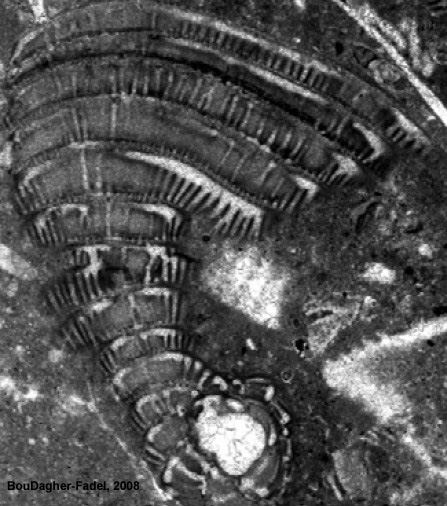 |
Test: planispiral, compressed, early stage peneropliform, with a later part having flaring chambers crossed by irregular pillars, but lacking a cyclical stage.
Geologic range: Eocene
|
![]() 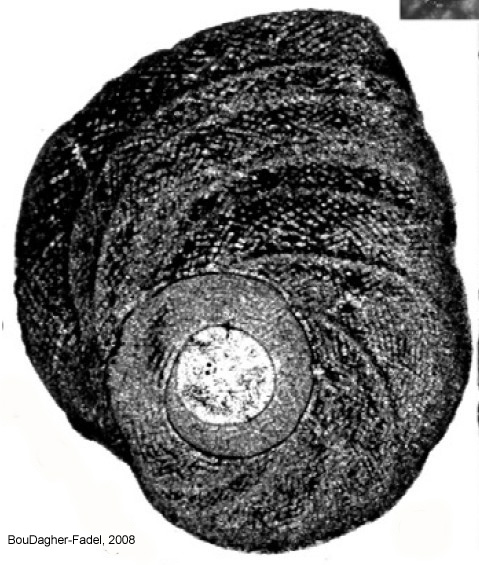 |
Test: large, operculine to discoid, early stage
peneropline rapidly flaring and may become cyclical in later stage. Chamber: numerous, and subdivided by oblique septula into small chamberlets that communicate through stolons.
Geologic range: Middle to late Eocene
|
SUBORDER ROTALIINA
- Test: multilocular with a calcareous wall, of perforate hyaline lamellar calcite
- Aperture: simple or have an internal toothplate
- Geologic range: Triassic to Holocene
Superfamily NUMMULITOIDEA
- Test: planispiral or cyclic, lenticular multicamerate, with septal flap and canaliculated septa. A spiral marginal cord and spiral canal system is present in early forms, but is modified in advanced forms or replaced by intraseptal canals.
- Geologic range: Paleocene to Holocene
Family Pellatispiridae
- Test: planispiral, having no marginal cord, but radial and vertical canals or fissures are present. Spiral and umbilical sides are not differentiated. Planispiralevolute chambers are connected by a single intercameral foramen
- Geologic range: Paleocene to Eocene
- Genera: Biplanispira; Bolkarina; Miscellanea; Pellatispira; Serraia; Vacuolispira
![]() 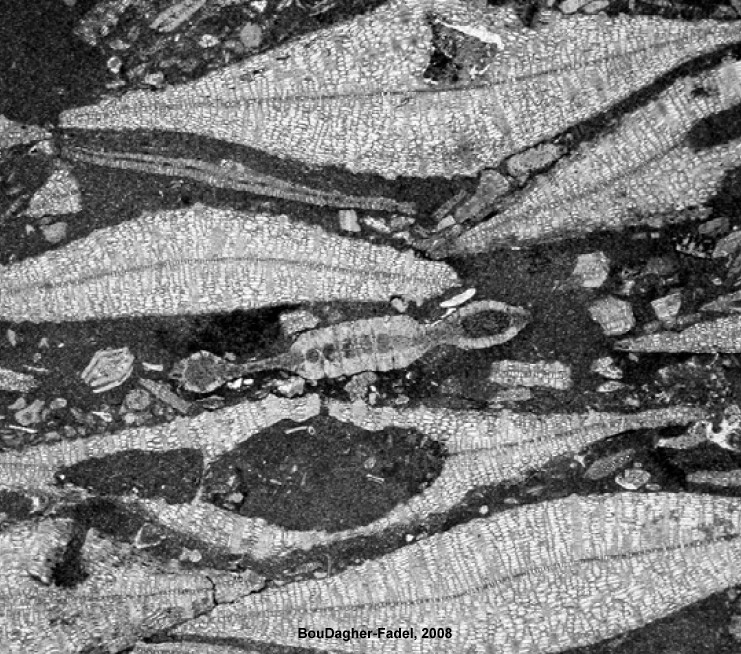 |
Test: Biconvex, early chambers, with a planispiral involute test in the early stage, and spiralling into two evolute spirals, with thick lateral laminae, one on each side of the equatorial plane.The equatorial plane is covered by pillars with pores or canals. The later stage may become annular, with narrow marginal interlamellar cavities, formed by mostly imperforate
walls suspended on radial spikes
Geologic range: Middle to Late Eocene
|
![]() 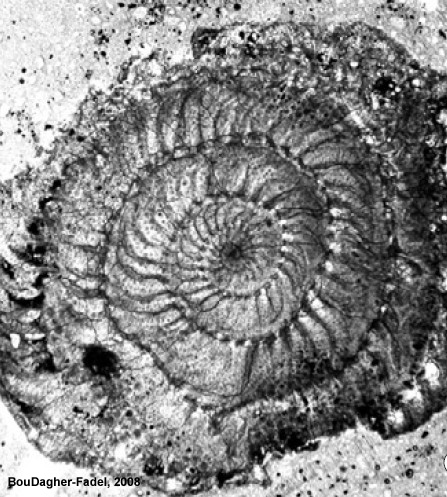 |
Test: lenticular angular, have few whorls, strongly
ornamented with very coarse perforation, raised rounded pustules, pillars, raised ridges and raised bars, dividing the space between longitudinal ridges. Bilamellar septa are quite distinct.
Geologic range: Paleocene
|
![]() 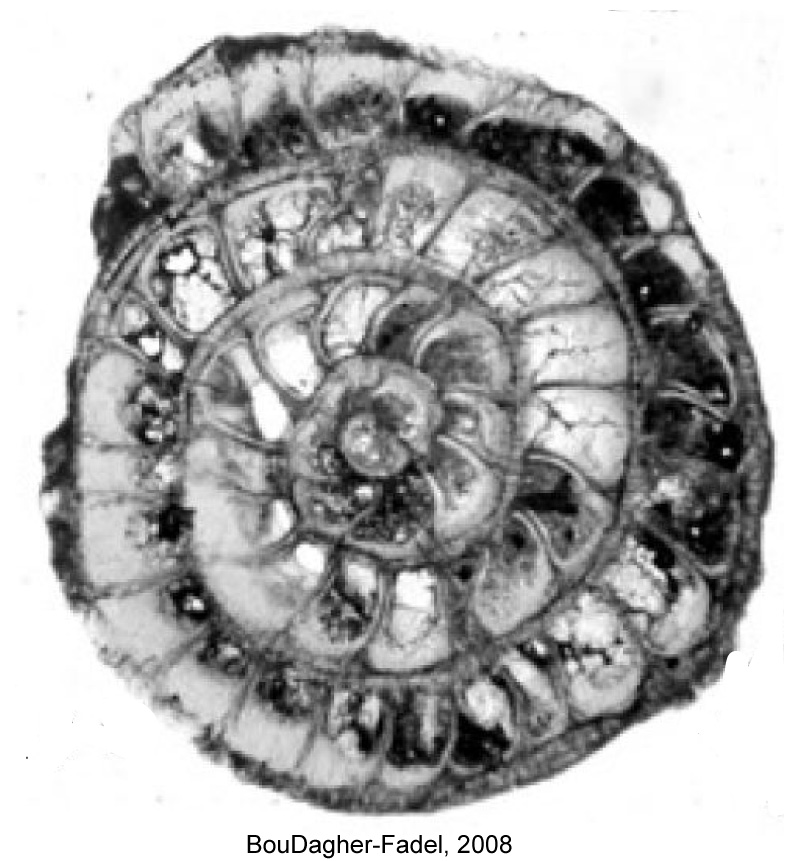 |
Test: flattened lenticular to discoidal, evolute
planispiral. Double septa enclose the intraseptal canals. A supplemental skeleton forms a thick canaliculated crest, with densely grouped parallel, radial canals, extending in the equatorial direction
Geologic range: Late Middle Eocene to late Eocene
|
![]()  |
Test: thickly lenticular to globular, with early evolute, planispiral chambers that support a heavy lateral supplemental skeleton, that is pierced by numerous radial canals. Later the spiral chambers are replaced by concentric arrangements of isolated chamberlets or interlamellar cavities, supported by pillars and covered by strong secondary lamellation to form thick,
perforate walls supported by pillars
Geologic range: Late Eocene
|
Family Nummulitidae
- Test: planispiral involute or evolute with septal, marginal and vertical canals
- Geologic range: Paleocene to Holocene
Subfamily Heterostegininae
- Test: Planispiral, with a canaliculate marginal cord, and septal canal trabeculae, but with true secondary septa, developed right across the chamber, forming chamberlets.
- Geologic range: Paleocene to Holocene
- Genera: Grzybowskia; Heterostegina; Spiroclypeus; Tansinhokella; (Planostegina)
![]() 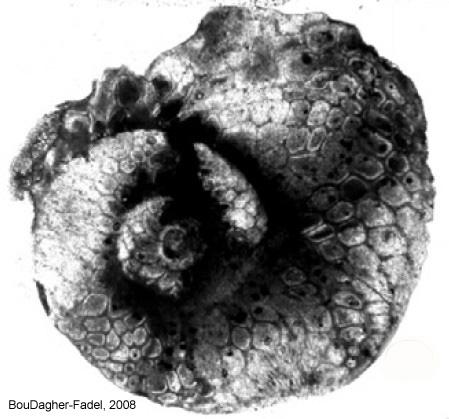 |
Test: wholly involute with favosely shaped, polygonal
chamberlets
Geologic range: Late Eocene
|
![]() 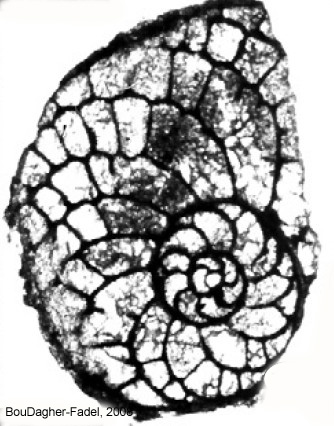 |
Test: thick, planispiral, involute to evolute with chambers divided by secondary septa to form small chamberlets. No alar prolongations, but with raised
sutures.
Geologic range: Late Eocene to Holocene
|
![]()  |
Test: planispiral, involute, with numerous narrow
chambers increasing rapidly in height, divided into alternating chamberlets and tiers of lateral chamberlets on either side. Adjacent chamberlets of the same primary chamber, and adjacent chamberlets of successive chambers communicate
with pore-like apertures.
Geologic range: Late Eocene to Early Miocene
|
![]() 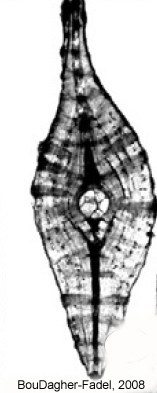 |
Test: planispiral, involute, with marginal cord, and bilamellar and canaliculated septa. It possesses groups of embracing alar prolongations, which are divided into chamberlets and seen in axial section, however, unlike Spiroclypeus, it lacks cubiculae.
Geologic range: Late Eocene to Early Miocene
|
Subfamily Nummulitinae
- Test: planispiral involute or evolute, with a canaliculate marginal cord, and septal canal trabeculae but without secondary septa forming chamberlets. They may become annular in more advanced forms.
- Geologic range: Late Cretaceous to Holocene
- Genera: Assilina; Nummulites; Operculina; Operculinella; Planocamerinoides; Ranikothalia
![]() 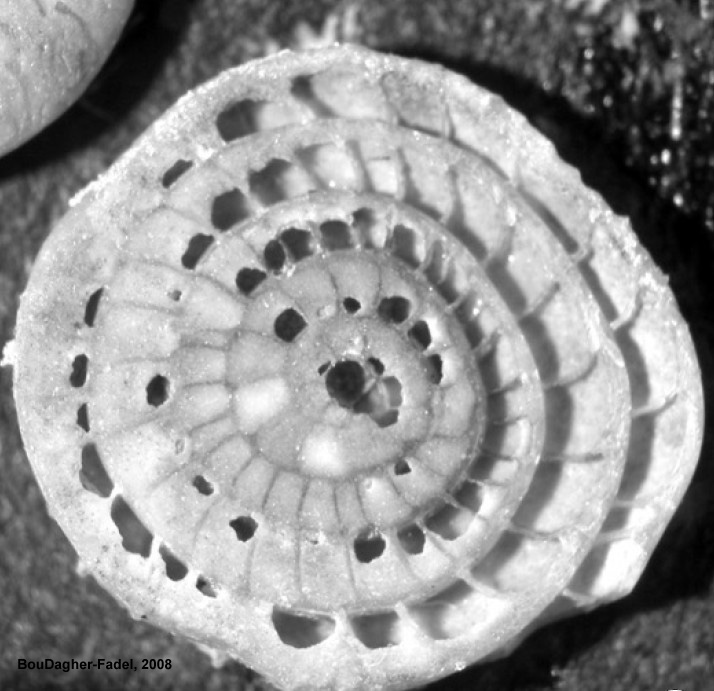 |
Test: tightly coiled, flat to biumbilicate, evolute with
numerous chambers per whorl. The rate of whorl growth is slow resulting in a test without alar prolongations. The marginal cord is thick with a coarse canal system
Geologic range: Late Paleocene to Middle Eocene
|
![]() 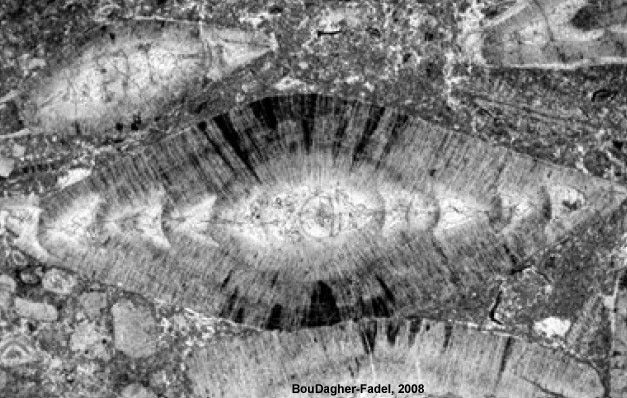 |
Test: lenticular, planispiral, involute, tightly coiled
with numerous whorls. Chamber: simple with distinct marginal cord on the periphery and ramified canals within the sutures, which may be radial, sigmoid,meandrine or reticulate. Trabeculae are present, and there are pronounced alar prolongations.
Geologic range: Middle Paleocene to Early Oligocene
|
![]() 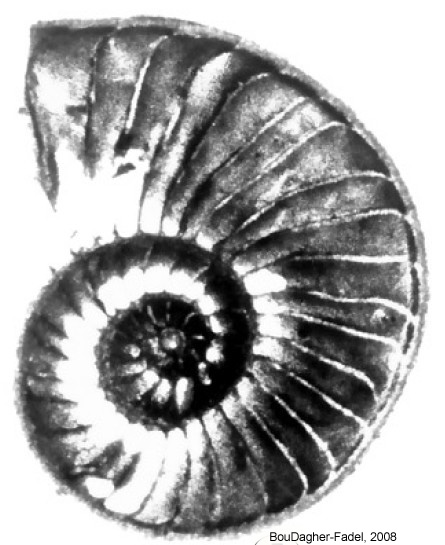 |
Test: planispiral, evolute lenticular to compressed and loosely coiled.
Chambers: simple; trabeculae are absent.
Sutural canals: forked or branching.
Geologic range: Late Paleocene to Holocene
|
![]() 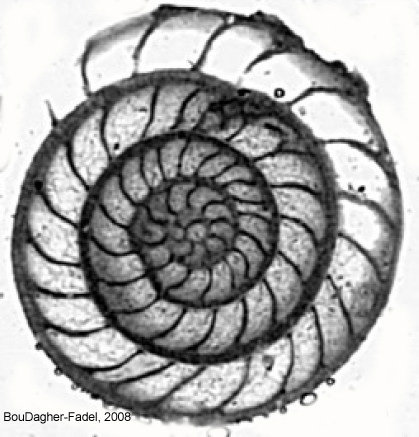 |
Test: The strong dimorphism seen between microspheric and megalospheric forms of Oligocene specimens of Nummulites is never seen in Operculinella.The presence of trabeculae in
Nummulites and their absence from Operculinella is noteworthy, but, most importantly, the diameter of the megalospheric protoconch of Nummulites (in both
simple and complex forms) is much greater than the diameter of the proloculus of Operculinella. The megalospheric Operculinella persists to the Holocene but the large protoconch of true Nummulites does not occur above the Early Oligocene.
Geologic range: Oligocene to Holocene
|
![]() 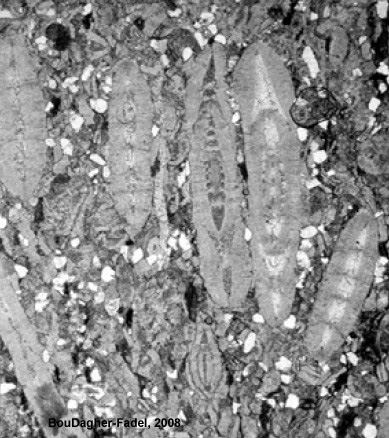 |
Test: biumbilicate with multilamellar thickenings
over the umbonal area.
Geologic range: Late Paleocene to Middle Eocene
|
![]() 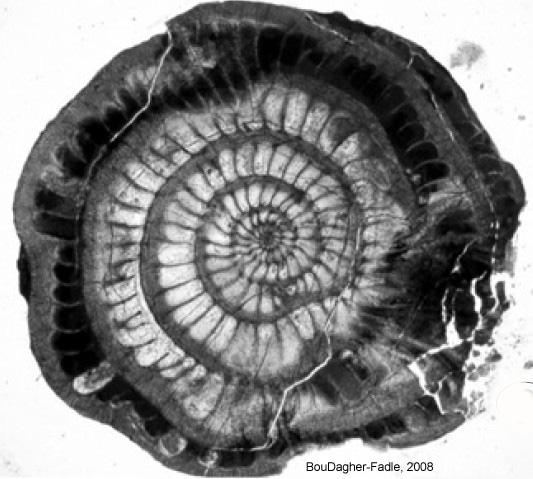 |
Test: lenticular with alar prolongations, initially
involute, becoming evolute in the last whorls. Thick marginal cord with a coarse canal system that connects to simple vertical septal canals. Trabeculae are present.
Geologic range: Late Paleocene
|
Family Cycloclypeidae
- Test: concentric annular, whollyevolute chambers, each chamber being divided into numerous chamberlets in a median plane and each chamberlet separated from adjacent chamberlets by straight canaliculated walls.
- Geologic range: Eocene to Holocene
- Genera: Cycloclypeus
Family Orthophragminidae
- Test: this family has a Cycloclypeus-like or operculinid microspheric juvenile form
- Geologic range: Middle Paleocene to Holocene
Subfamily Discocyclininae
- Test: Megalospheric forms have a subspherical protoconch enclosed by a larger reniform deuteroconch. Microspheric forms have an initial spiral of small chambers, and later stages with cyclical chambers subdivided by septula into small rectangular chamberlets connected by annular and radial stolons. There is a fine equatorial layer and small lateral chamberlets. A small, intraseptal and intramural canal system is present.
- Geologic range: Middle Paleocene to Late Eocene
- Genera: Actinocyclina; Asterophragmina; Discocyclina; Hexagonocyclina; Nemkovella; Pseudophragmina
![]() 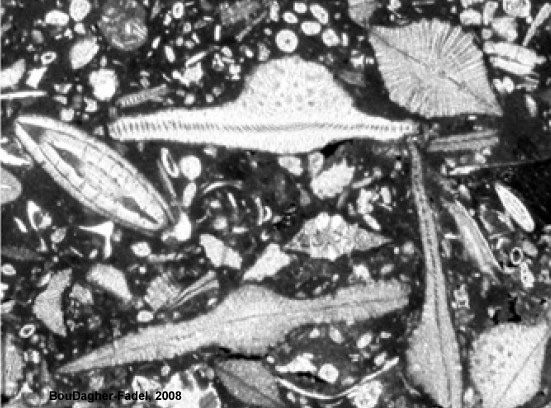 |
Test: Distinct rays formed by a proliferation of broad and low lateral chamberlets
Geologic range: Middle to Late Eocene
|
![]() 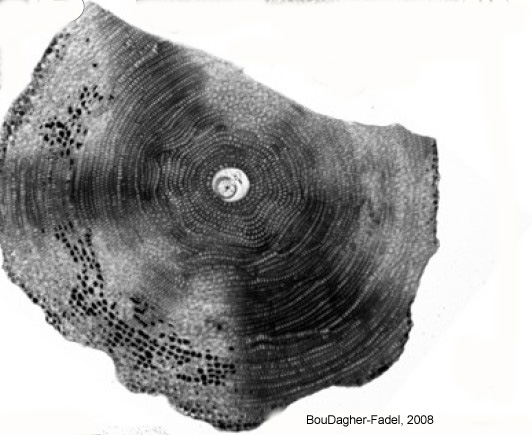 |
Test: Discoidal, flat, with an equatorial layer composed of concentric rings of rectangular chamberlets, those of successive cycles alternating in position. Lateral chamberlets are connected with the equatorial layer by vertical stolons. Annular stolons occur at the proximal end of the radial walls and connect adjacent chamberlets.
Geologic range: Middle Paleocene to Late Eocene
|
![]()  |
Test: similar to Discocyclina but with two
symmetrical auxiliary chambers on each side of the nucleoconch and four spirals, and predominantly hexagonal equatorial chamber.
Geologic range: Early to Middle Eocene
|
![]() 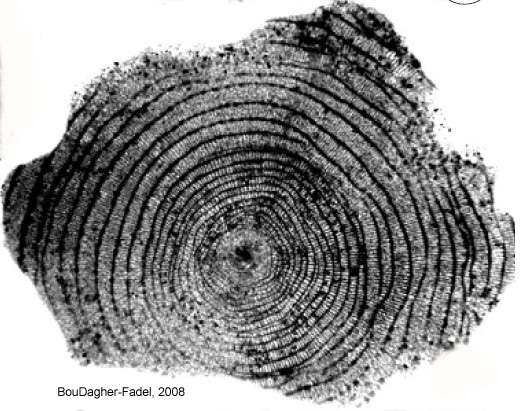 |
Test: circular to subquadrate in outline. An eulepidine embryo is surrounded by a single ring of large nepionic chambers, which are followed by smaller equatorial chambers. Numerous irregular layers of lateral chamberlets occur on both sides of the single equatorial layer.
Geologic range: Eocene
|
Subfamily Orbitoclypeinae
- Test: microsphereic tests have an early planispiral coil, while megalospheric tests have a globular protoconch, enclosed by a larger reniform deuteroconch. Members of this subfamily may occur with or without ribs.
- Chambers: There is a single equatorial layer of chamberlets and several layers of small lateral chamberlets, and cyclical chambers are not subdivided into chamberlets. Chambers have four stolons.
- Geologic range: Middle Paleocene to Late Eocene
- Genera: Asterocyclina; Neodiscocyclina; Orbitoclypeus; Stenocyclina
Superfamily PLANORBULINOIDEA
- Test: trochospiral in early stages, later may be uncoiled and rectilinear, or biserial, or with many chambers in the whorl. They are found with intra- to extraumbilical apertures, and additional equatorial apertures may be present.
- Geologic range: Early Cretaceous to Holocene
Family Eoannularidae
- Test: bilamellar perforate, with a bilocular megalospheric embryo followed first by orbitoidal chamberlets, which change later to cyclical chambers. The cyclical chambers are subdivided into rectangular chamberlets or are unsubdivided.
- Chambers: Microspheric initial chambers are arranged in a peneroplid-like spire that changes into annular chambers by a progressive increase in chamber width.
- Geologic range: Middle Eocene
- Genera: Eoannularia; Epiannularia
![]() 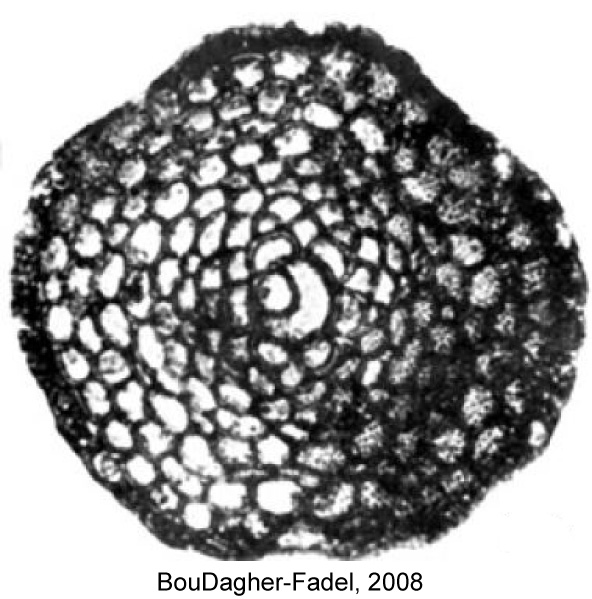 |
Test: discoidal, flat with subdivided annular chambers and lamellar thickening only in the early stage. The megalospheric form has a protochonch that is completely enclosed by the deuteroconch, and chambers following the bilocular embryo occurring as an annular series in a single layer.
Geologic range: Middle Eocene
|
Family Linerinidae
- Test: bilamellar with a lobate outline. The megalospheric embryo has a quadrilocular early stage, with three initial chambers separated by flattened walls, followed by a fourth arcuate chamber with apertures on both sides. Later chambers occur in orbitoidal growth, with crosswise-oblique stolons.
- Geologic range: Middle to Late Eocene
- Genera: Caudriella; Linderina
![]() 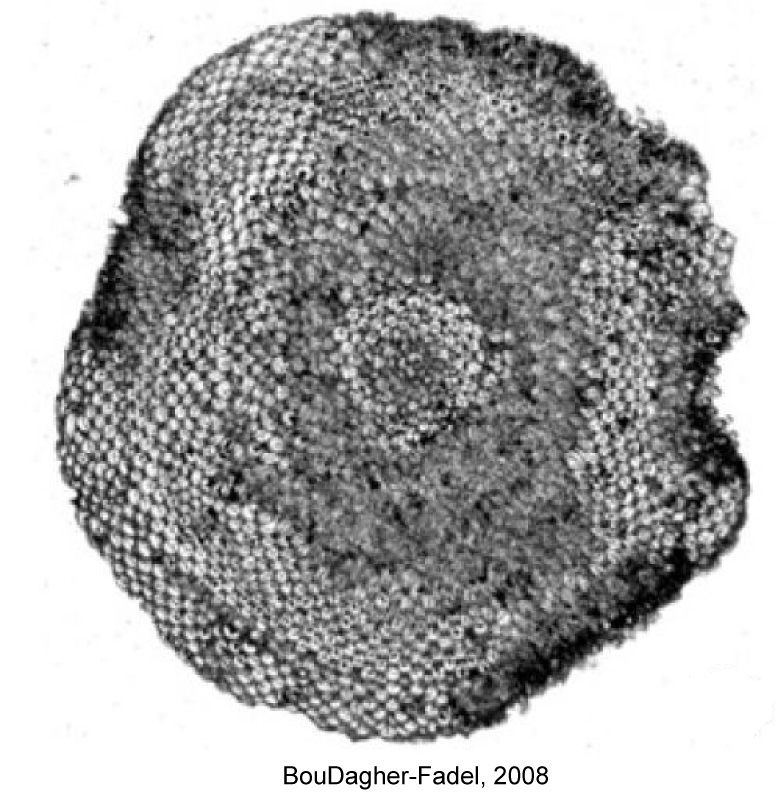 |
Test: large, discoid without lateral chamberlets and
considerable thickening in the early stage on both sides of the test, formed by the superposition of the successive involute outer lamellae. Orbitoidal chambers, consisting of small arched chamberlets, occur in concentric series, with successive layers alternating in position. There are no annular stolons, nor stolons in the distal wall of the chamberlets.
Geologic range: Middle to Late Eocene
|
Schematic figure highlighting the differences between Linderinidae and
Eoannularidae (BouDagher-Fadel, 2008)
Family Planorbulinidae
- Test: free or attached, with an early stage that is trochospiral, later becoming discoid, cylindrical or conical
- Aperture: single or multiple
- Geologic range: Eocene to Holocene
- Genera: Neoplanorbulinella; Peelella; Planolinderina; Plaorbulina; Planorbulinella; Tayamaia
Family Cymbaloporidae
- Chamber: occur in a single layer
- Geologic range: Late Cretaceous to Holocene
- Genera: Cymbalopora; Eofabiania; Fabiania; Gunteria; Halkyardia
![]() 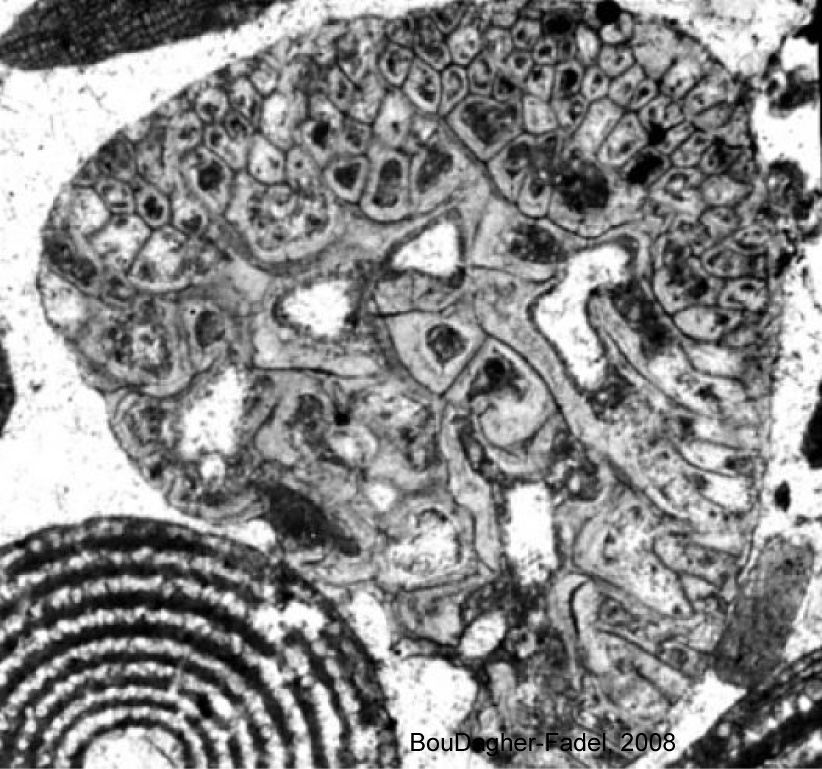 |
Test: conical, with deeply excavated centre. Early stage has two globose thick-walled and perforate chambers, later chambers are cyclical with horizontal and vertical partitions.
Aperture: a single row of pores opening into the
large umbilicus.
Geologic range: Middle Eocene to Middle Oligocene
|
![]() 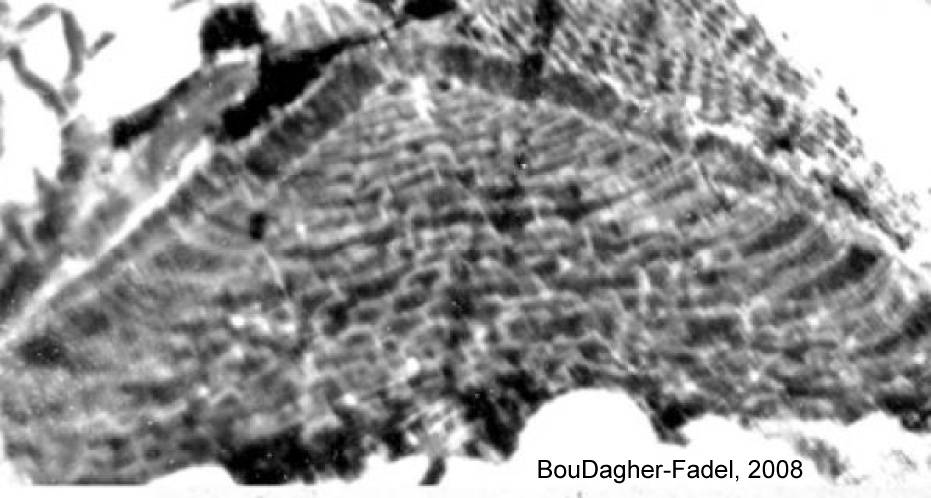 |
Test:biconvex, with an embryont consisting of a large protoconch and deuteroconch, and two primary auxiliary chambers (PACs). The umbilicus is filled with horizontal bilamellae and connecting pillars.
Geologic range: Middle Eocene to Middle Oligocene
|
Family Victoriellidae
- Test: attached or may be free in the juvenile stage, with a trochospiral early stage, later becoming an irregular mass of chambers.
- Geologic range: Late Cretaceous to Holocene
Subfamily Carpenteriinae
- Test: attached, trochospiral throughout, planoconvex with a large aperture, open in the umbilicus
- Geologic range: Paleocene to Holocene
- Genera: Carpenteria; Neocarpenteria
Subfamily Rupertininae
- Test: attached, with a distinct flattened disk but coiling grows out away from the site of attachment. Late
- Geologic range: Cretaceous to Holocene
- Genera: Biarritzina
Subfamily Vitoriellinae
- Test: The juvenile stage may be free living, but later stages are attached. High-spired forms develop around a hollow axis, with pillar-like thickenings in the walls
- Aperture: an umbilical slit bordered by a lip
- Geologic range: Middle Eocene to Holocene
- Genera: Eorupertia; Korobkovella; Maslinella; Victoriella; Wadella
![]()  |
Test: highly trochospiral, enrolled about an
axial hollow.
Wall: coarsely perforate with small pillars between the perforations.
Geologic range: Middle to Late Eocene
|
![]()  |
Test: conical, usually with a free juvenile stage and a small attachment area near the apex, consisting of a few inflated chambers with pillar-like thickenings in the wall. In the adult stage the coiling is highspired, with three to four subspherical chambers per whorl (not enclosing), either with an umbilical depression or arranged round an axial hollow
Septa: trilamellar
Geologic range: Middle to Late Eocene
|
Superfamily ACERVULINOIDEA
- Test: trochospiral to discoidal and encrusting, consisting of numerous irregularly
- formed chambers
- Geologic range: Paleocene to Holocene
Family Acervulinidae
- Test: free or attached. A low trochospiral in the initial early stage is followed by inflated chambers spreading over the substrate in more than one layer, forming an irregular mass, that appears to possess no apertures other than the pore-like cribrate openings in their upper, distal surfaces.
- Geologic range: Paleocene to Holocene
- Genera: Discogypsina; Gypsina; Orbitogypsina; Protogypsina; Solenomeris; Sphaerogypsina; Wilfordia
![]() 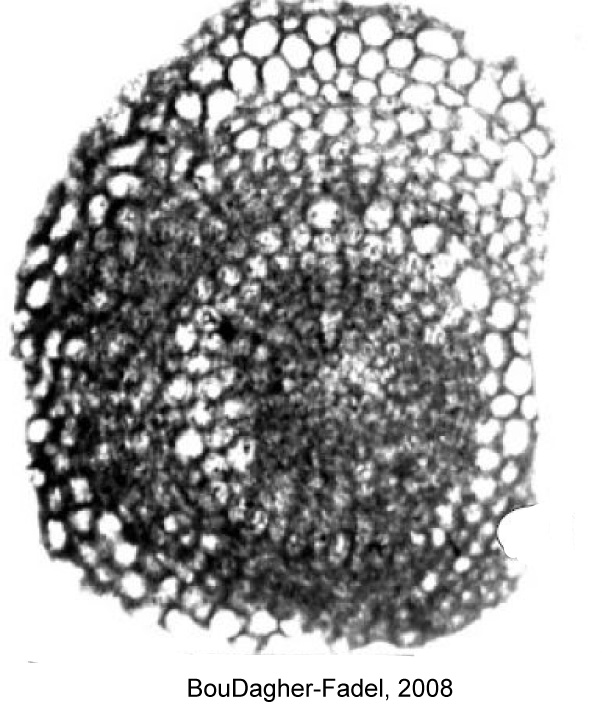 |
Test: lenticular, flattened, with an equatorial layer of
slightly larger thicker chambers, separating lateral layers of smaller irregularly arranged chambers with successive layers showing no alignment.
Wall: coarsely perforate with no stolon system.
Geologic range: Late Eocene to Holocene
|
![]()  |
Test: spherical. The megalospheric apparatus has a spherical protoconch and a kidney-shaped deuteroconch followed by large ovoid chambers. Geologic range: Palaeocene
|
![]() 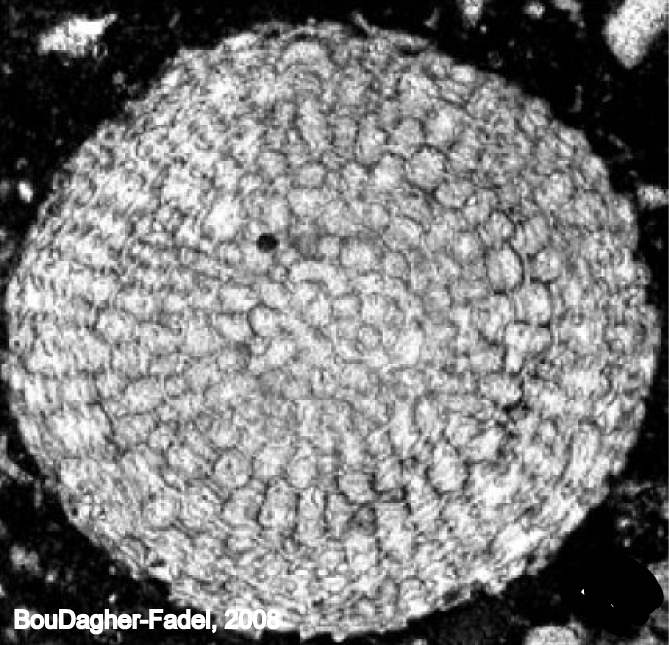 |
Test: small, almost spherical, chambers added in
numerous layers, those of successive layers are aligned. Chamber roofs are perforate but the walls are thick and imperforate
Geologic range: Paleocene to Holocene
|
![]() 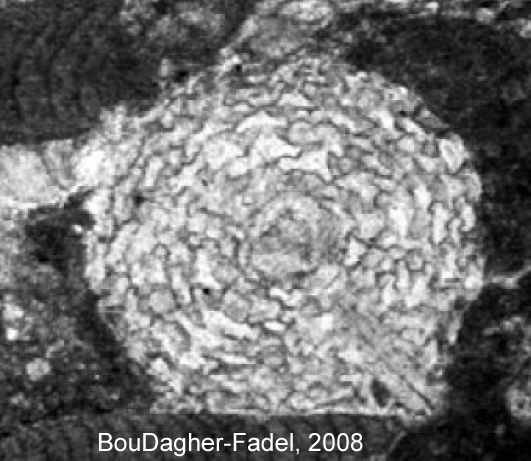 |
Test This form has no true initial spire and a complex embryont with a short nepionic spiral, relatively weak ‘‘pseudopillars’’ form in the walls of lateral chambers, with no massive thickenings, and its chambers are clearly rectangular in section.
Geologic range: Late Eocene
|
Family Homotrematidae
- Test: attached with a trochospiral early stage, later chambers grow in a massive branching structure
- Geologic range: Eocene to Holocene
- Genera: Sporadotrema
Superfamily ASTERIGERINOIDEA
- Test: trochospiral to planispiral, with a closed umbilicus. Chambers occur with internal partitions. Supplementary chamberlets develop around the umbilicus. The aperture is umbilical, and may extend up the apertural face
- Geologic range: Late Cretaceous to Holocene
Family Amphisteginidae
- Chamber: numerous with interseptal pillars
- Aperture: a narrow slit
- Geologic range: Eocene to Holocene
- Genera: Amphistegina
![]()  |
Test: trochospiral, asymmetrically lenticular,
involute with an angular, carinate periphery and lobed sutures
Chamber: strongly curved back at the periphery.
Geologic range: Eocene to Holocene
|
Family Boreloididae
- Tests: tests occur with only the later chambers divided into chamberlets. The protoconch is bilocular and is followed by an early trochospiral stage, the later stages are planispiral and involute
- Geologic range: Late Paleocene to Eocene
- Genera: Boreloides; Eoconuloides
Family Lepidocyclinidae
- Test: discoidal, involute, biconvex with a broad centrum, which grades into a narrow flange. Adauxiliary chambers may be present. The primary spire persists into the equatorial layer, or with annular rings of chamberlets that follow the embryont immediately. Stacks of ‘‘lateral chamberlets’’ (cubiculae) occur on each side of the median chamberlets. Pillars may be present between adjacent vertical stacks of cubiculae or scattered in the central region. The chamber walls are perforated by stolons, but there is no canal system.
- Geologic range: Middle Eocene to Middle Miocene
Subfamily Helicolepidininae
- Test: Members of this subfamily have tests in which the spiral arrangements completely surround the bilocular embryo, which is surrounded by a thickened wall, and is lacking auxiliary chambers.
- Geologic range: Middle Eocene to Middle Miocene
- Genera: Eulinderina; Helicolepidina; Helicostegina; Helicosteginopsis; Polylepidina
![]() 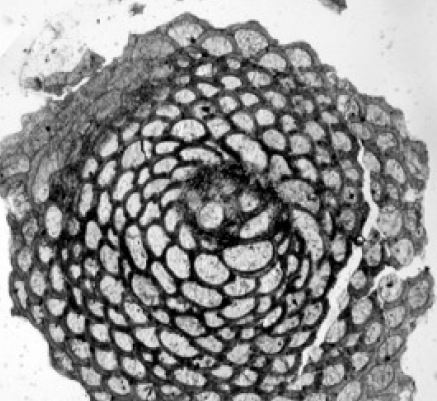 |
Test: lenticular, with an eoconuloid early stage, followed by a trochoid coil with a thick wall and many rows of arcuate median chambers that are connected by stolons.
Geologic range: Middle Eocene
|
![]() 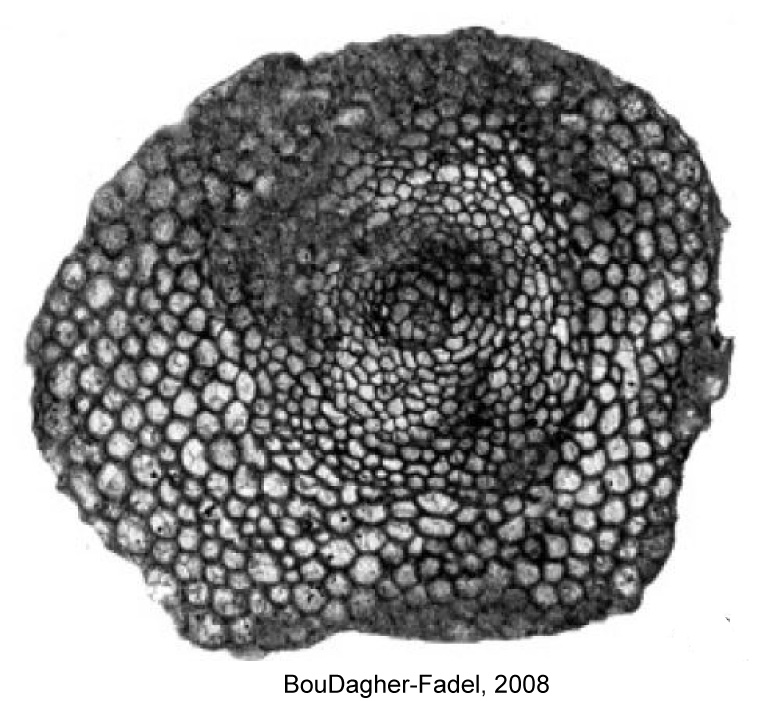 |
Test: lenticular, with a small eoconuloid early stage
followed by a loose planispiral coil (the helicolepidine string) and a series of large imbricate chambers outside the helicolepidine string. The median layer has small arcuate chambers connected by single or double apertures. Lateral chambers are
well developed.
Geologic range: Middle to Late Eocene
|
![]() 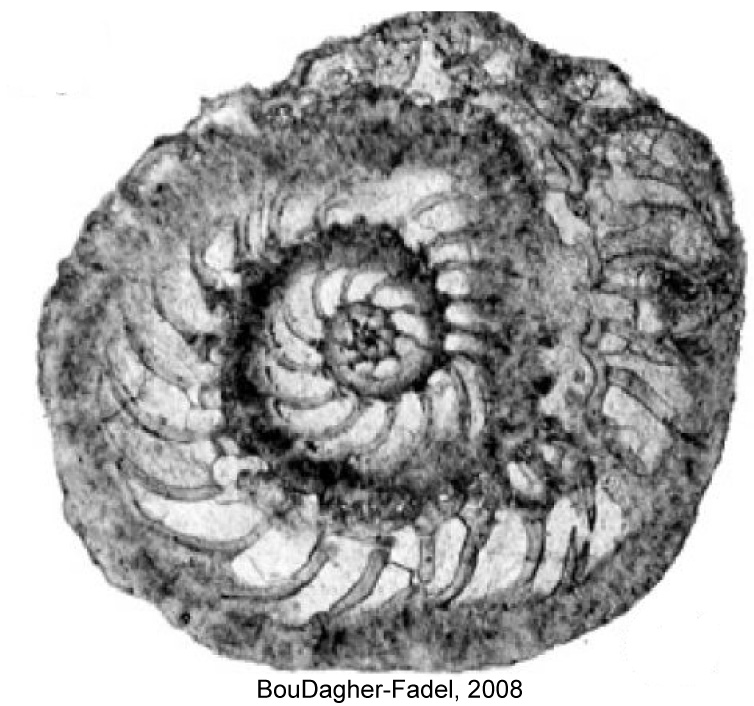 |
Test: lenticular, with an eoconuloid
early stage which constitutes the larger part of the test. The chambers in the last stage are subdivided into subsidiary chamberlets, which consist of two or
three rows of arcuate chamberlets growing around the last eoconuloid whorl.
Geologic range: Eocene
|
![]()  |
Test: The embryo consists of a protoconch and
deuteroconch surrounded by a thick wall. The equatorial layer is formed by chambers arranged in two or more embryonic spires, followed by a cyclical phase. All chambers have one basal aperture from which the next chamber is formed. All chambers with two apertures then produce two new chambers, which eventually gives rise to cyclical growth.
Geologic range: Late Middle Eocene
|
Subfamily Lepidocyclininae
- Test: Lepidocyclininae have a bilocular or multilocular embryonal stage, surrounded by a thickened wall and adauxiliary chambers. Spirally arranged chambers do not completely surround the embryon.
- Chambers: Post-embryonic chambers are cyclical, arcuate to hexagonal in shape, usually with two or more apertures. Lateral chambers are well differentiated from the equatorial layer.
- Geologic range: Middle Eocene to Middle Miocene
- Genera: Astrolepidina; Eulepidina; Lepidocyclina; Pseudolepidina
Superfamily ORBITOIDOIDEA
- Test: discoidal to lenticular with prominent dimorphism, as in most orbitoidal species both megalospheric and microspheric generations are found. Microspheric specimens have a distinctly small protoconch (usually about 20 microns), while megalospheric forms have a distinctive embryonic stage, enclosed in a thicker wall. Equatorial and lateral chambers may be differentiated or indistinguishable.
- Geologic range: Late Cretaceous to Oligocene
- Genera: Actinosiphon; Daviesina; Neosivasella; Orbinosiphon; Sirelella
![]() 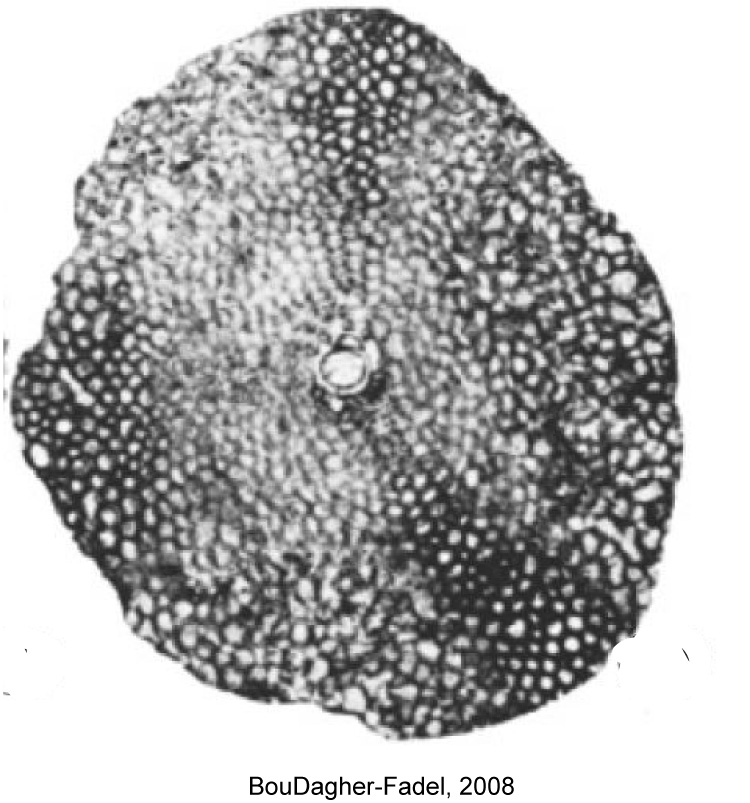 |
Test: lenticular with well-developed polygonal to
hexagonal equatorial and lateral chambers. The embryont consists of a large subspherical protoconch and a smaller reniform deuteroconch, and is followed by a spire of about 11 chambers. Equatorial chambers of the same cycle communicate by median stolons, while lateral chambers communicate through pores
Geologic range: Late Paleocene
|
![]() 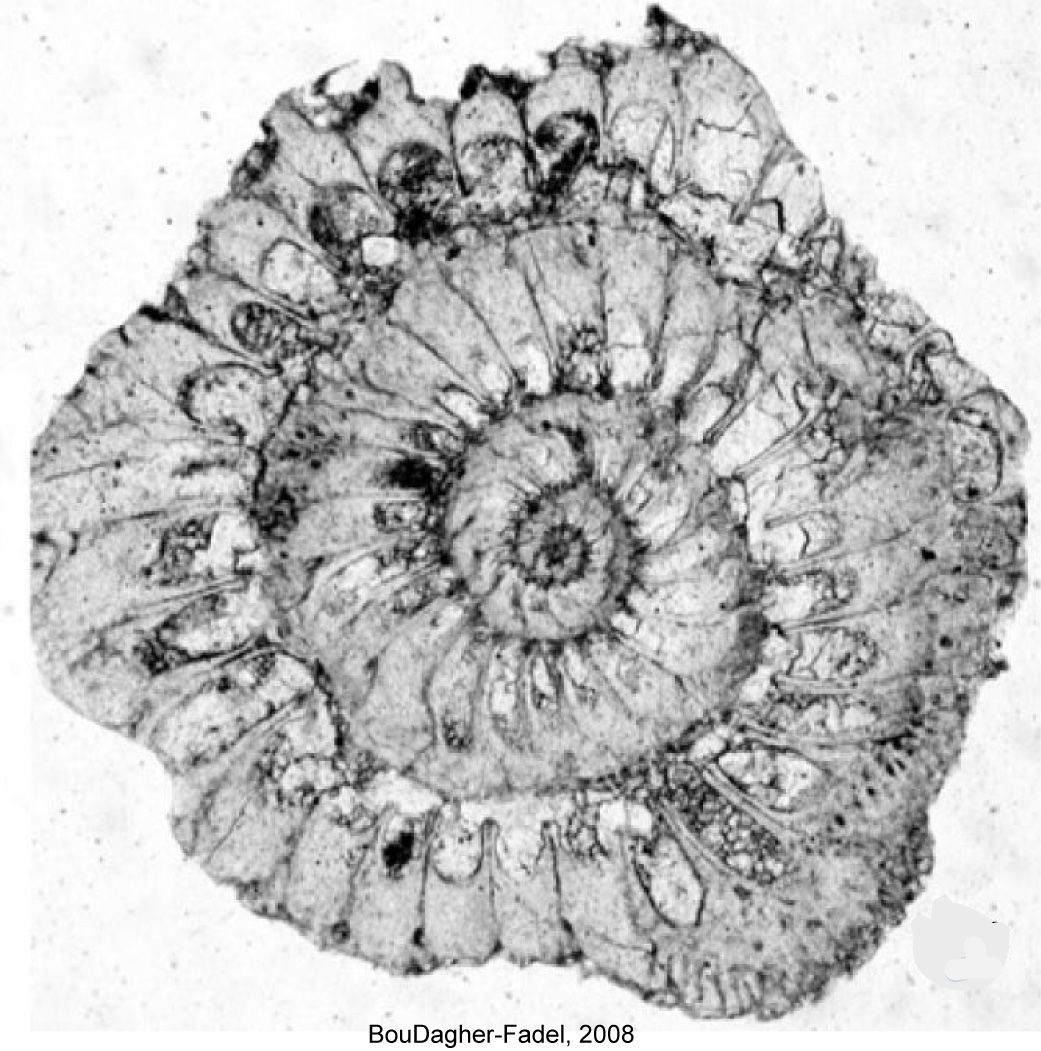 |
Test: flattened, trochospiral and large, with slightly unequal alar prolongations. Wall: thick, perforated and ornamented with thick pillars.
Septa: secondarily doubled with no marginal cord. The umbilicus has a flap or plate. Prominent umbilical pillars, fissures and complex intrasepta canals are distributed unequally on both sides of the test.
Geologic range: Middle Paleocene to Late Oligocene
|
![]() 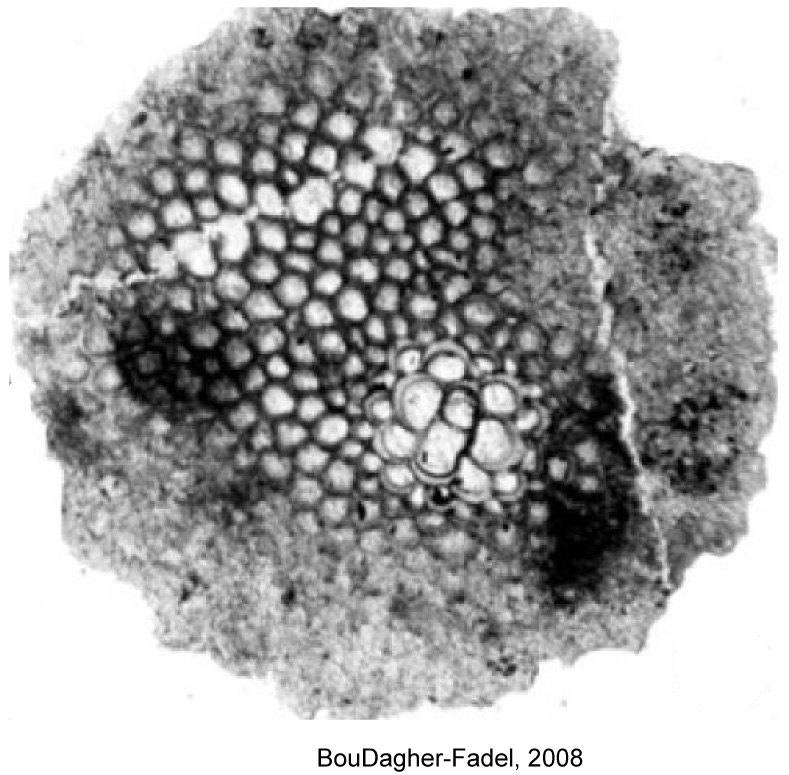 |
Test: has epi-auxiliary chambers, but it lacks the thick embryonic wall (similar to Orbitoides)
Geologic range:Paleocene
|
Family Orduellinidae
- Test: free, dimorphic, spherical with subrectangular chambers arranged in multiple spirals in the early part of the test. Later chambers are arcuate and connected by stolons. They are added in concentric series in an orbitoidal manner
- Aperture: single, simple, basal slit in the early stage
- Geologic range: Palaeocene
- Genera: Orduella
Superfamily ROTALIOIDEA
- Test: involute to evolute, initially trochospiral or planispiral, commonly with many chambers in numerous whorls. As new chambers are added septal flaps attach to the previous apertural face and enclose radial canals, fissures, umbilical cavities, and intraseptal and subsutural canals
- Walls: made of perforate hyaline calcite, and generally optically radial in structure. Primary apertures occur singly or as multiples. Small opening into the canal system may occur along the sutures.
- Geologic range: Late Cretaceous to Holocene
Family Rotaliidae
- Test: built of radially fibrous calcite and deposited in successive laminae. It forms a trochospiral with umbilical plugs, and throughout it have radial canals or fissures and intraseptal and subsutural canals.
- Aperture: umbilical, basal and single to multiple
- Geologic range: Late Cretaceous to Miocene
Subfamily Cuvillierininae
- Test: trochospiral to planispiral, with a canal system and vertical fissures. Umbilical
- and spiral sides not differentiated in structure.
- Geologic range: Late Cretaceous to Miocene
- Genera: Cuvillierina
Subfamily Rotaliinae
- Test: trochospiral with an umbilical plug. Radial canals, intraseptal and subsutural canals are present
- Geologic range: late Cretaceous to Early Miocene
- Genera: Dictyoconoides; Dictyokathina; Lockhartia; Medocia; Rotaliconus; Sakesaria
![]()  |
Test: conical with multiple intercalated spires of small
rectangular chamberlets. The umbilical side is filled by pillars separated by spaces and cavities of equal sizes. Intraseptal and subsutural canal systems are present.
Geologic range: Middle Eocene
|
![]() 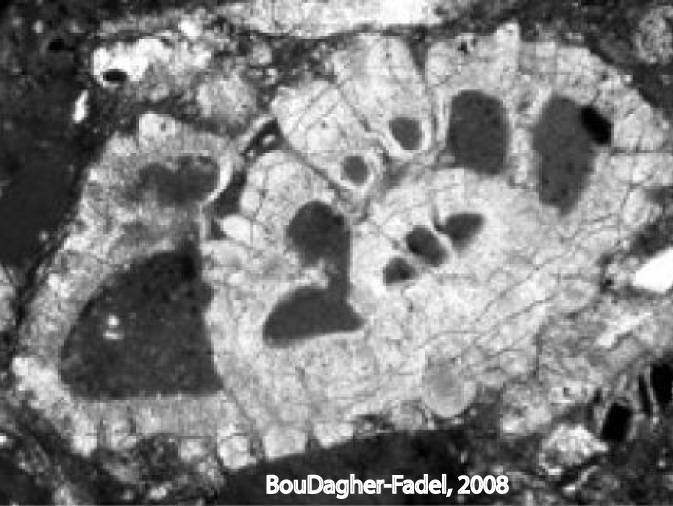 |
Test: conical to lenticular with a simple spire of numerous chambers, similar to Dictyoconoides but lacking the intercalated spires. The dorsal side is ornamented with nodes, and the umbilicus is filled with numerous pillars with numerous cavities communicating with the chambers
Geologic range: Paleocene to Middle Eocene
|
![]() 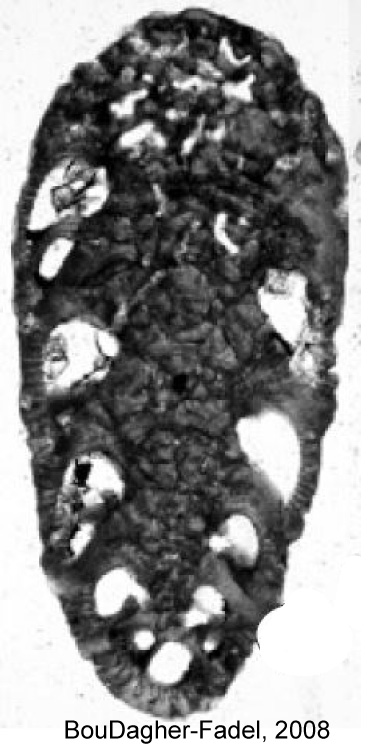 |
Test: elongate, with a very high trochospiral. The
umbilicus is filled with pillars; cavities communicate between the chambers as in Dictyoconoides
Geologic range: Paleocene to Early Eocene
|
Subfamily Pararotaliinae
- Test: trochospiral, with an enveloping canal system but with umbilical cavities.
- Geologic range: Late Cretaceous to Holocene
- Genera: Camagueyia; Neorotalia
Family Miogypsinidae
- Test: flattened to bioconvex. The microspheric form has a trochospiral or planispiral early spire, while the megalospheric form has a bilocular embryonal stage followed by a fan of median chamberlets
- Geologic range: Middle Oligocene to Middle Miocene
- Genera: Paleomiogypsina; Miogypsinella; Boninella; Miogysinoides; Miogysinodella; Miogypsina; Miogypsinita; Miolepidocyclina
Family Chapmaninidae
- Test: conical with a trochospiral initial part, followed by a uniserial part and a tubular apertural system.
- Septa: invaginated into tube pillars.
- Geologic range: Late Palaeocene to Late Miocene
- Genera: Angotia; Chapmanina; Crespinina; Ferayina; Sherbornina
The evolution of the conical forms of the Paleogene Rotalioidea (after Deloffre and Hamaoui, 1973)
Family Calcarinidae
- Test: enrolled with protruding spines
- Geologic range: Late Cretaceous to Holocene
- Genera: Silvestriella; Meghalayana
![]() 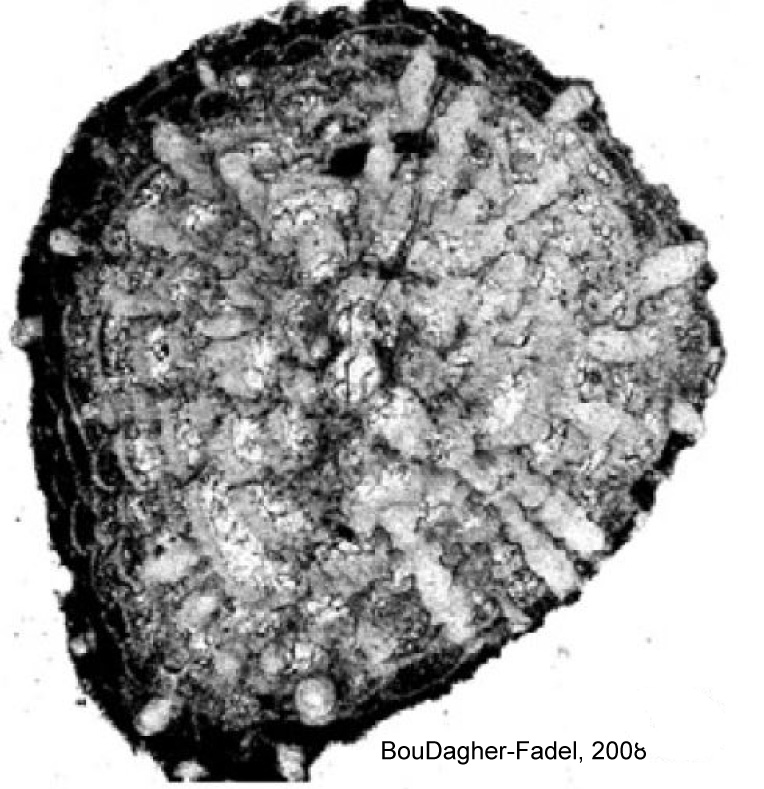 |
Test: large, with three to four large radial spines,
resulting in a tetrahedral form. Spines arise from the early whorl of chambers and widen rapidly. Spine canals arise from the interseptal spaces of the early chambers. The spine surface has numerous large pores. Solid pillars may be present between the
outermost chambers.
Geologic range: Middle Eocene
|
![]() 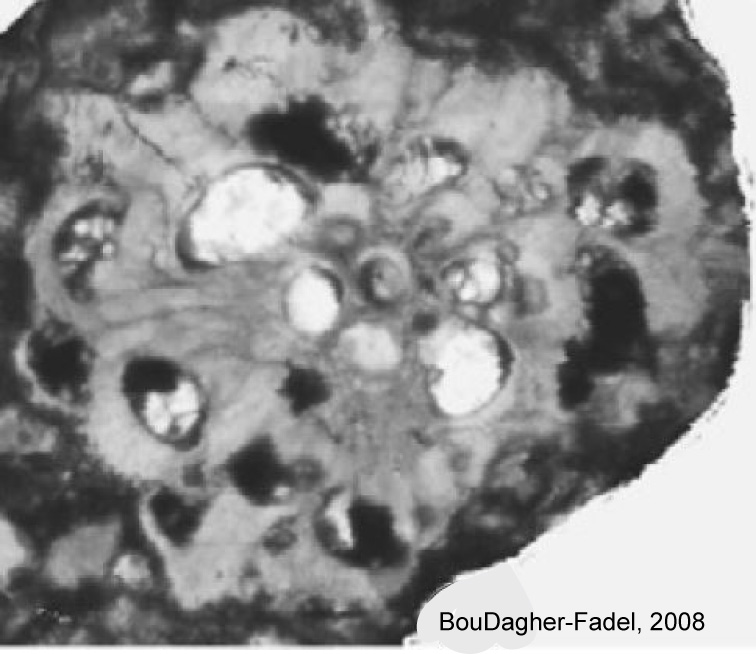 |
Test: compressed, planispiral and involute, may be partialovoidal to ellipsoidal with four spines.
Geologic range: Late Eocene
|
Family Elphidiidae
- Test: planispiral to trochospiral and uncoiled with sutural pores, canals and supplementary apertures.
- Aperture: single or multipleGeologic range: Paleocene to Holocene
- Genera: Elphidium; Pellatispirella
![]() 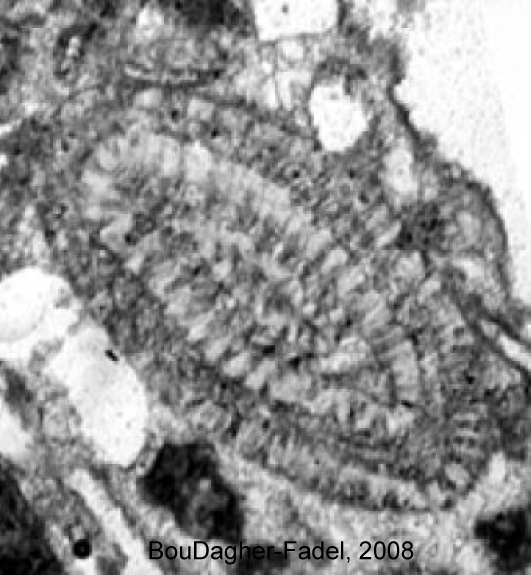 |
Test: lenticular, planispiral involute or partially evolute
with deeply incised sutures. The umbilical plug has vertical canals communicating with the spiral canals
Geologic range: Eocene to Holocene
|
![]()  |
Test: lenticular, planispiral and involute with an
umbilicus perforated by canals.
Septa: folded at the base and have numerous
transverse canals.
Geologic range: Middle Eocene
|
References
BouDagher-Fadel, M.K., 2008. Evolution and Geological Significance of Larger Benthic Foraminifera. Developments in Paleontology and stratigraphy, v. 21, 540p.
Twitchett, R.J., 2006. The palaeoclimatology, palaeoecology and palaeoenvironmental analysis of mass extinction events. Palaeogeogr. Palaeoclimatol. Palaeoecol. 232, 190–213.